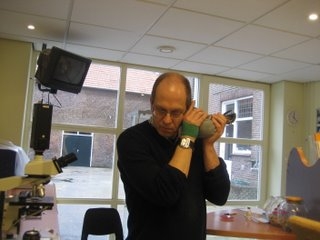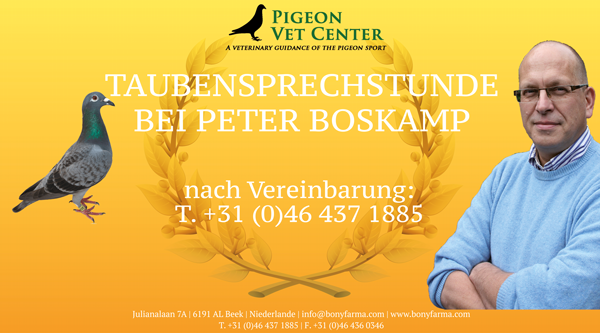Endoparasites - from veterinarian Peter Boskamp ...
Endoparasites
As for worms, I only want to discuss the species found in this region. The most common worms in pigeons are nematodes such as roundworms or hairworms. The tapeworm belongs to the cestodes and the pigeon bone gene to the trematodes (flukes). Worm infections are still regularly detected. What struck me once was that when I was first invited by a pigeon club to inspect the pigeons on site, there were many fanciers whose pigeons had worm infections. This occurs especially when the inspection takes place after the flying season. The mutual infection in the baskets is usually very strong. We can then often find that the level of performance of a club as a whole can be disappointing. Now worm eggs can stay for a long time, inside and outside of a loft. It is therefore always advisable to have regular stool checks carried out in the event of worm infections.
The roundworm (Ascaridae columbae)
Infections with this type of worm still occur regularly. Strikes affected by this can have lingering problems here. This is u.a. This is because the area surrounding the loft usually remains infected with worm eggs, which can then be picked up again by the pigeons. Or be carried in by the breeder so that the pigeons can become infected again. For serious worm infections, it is prudent to cauterize the blows periodically.
The adult roundworm lives in the small intestine and becomes about 3-7 cm long. The female roundworm can lay thousands of eggs. These eggs cannot be seen without a microscope. The worms have a direct cycle. This means that no intermediate host is required, as is the case with tapeworms and pigeon bones, for example.
After the female has laid the eggs, they are not immediately infectious. In a warm and humid environment, these worms only become infectious after 10-14 days. Infection in the baskets is in principle only possible if they are not properly cleaned and disinfected after the flights. If a pigeon picks up freshly laid worm eggs in the basket, they have already passed through the intestines before they are contagious.
If a pigeon picks up infectious worm eggs, they arrive in the pigeon's intestine. The roundworms live in the pigeon's small intestine. The larvae that come out of the eggs crawl towards the mucous membrane of the intestinal wall in which they nest. The larvae shed their skin several times in the intestinal wall. These first larval stages are not sensitive to the existing wormer products. Therefore, a worming cure should always be repeated before these larvae, which were not yet sensitive “grown up” and can produce eggs again themselves. The period between infection and the moment when the adult worms can produce eggs again is called the prepatent period. This takes about 30-40 days for roundworms.
Pathogenicity and clinical manifestations
The harmfulness of roundworms isn't all that bad in terms of disease-causing ability. Nevertheless, we must not underestimate an infection with roundworms. Some roundworms can reduce the condition of the pigeons a bit. Because the pigeon sport has now become a top sport, you cannot afford to leave a worm infection untreated. The roundworms eat with the pigeon, so to speak, and absorb part of the host's minerals, vitamins and trace elements. In addition, of course, other nutrients. The reduction in the availability of micronutrients is sometimes the reason why pigeons are less likely to shed down. With more severe infections, the pigeons lose weight and their condition suffers even more. The pigeons also tire faster. Diarrhea can also occur, with the faeces becoming like porridge at first. Either way, the pigeons also become more sensitive to other infections due to the attack of the defence.
Sometimes a pigeon can even die from a severe worm infection. This can happen when there are so many worm eggs in the intestine that an intestinal obstruction occurs, so to speak.
Pigeons that are stuck usually have more problems with worms. Possibly because the racing pigeons are more likely to decide to have a faecal examination done. Corners, seams and crevices should not be forgotten on pigeon lofts as soon as a worm infection has been detected. As I said, if a worm infection is detected, the loft should be burned out in addition to treating the pigeons. This because of the worm eggs. Disinfectants don't do much for a worm infection. In order to prevent the worm eggs from being caught with the burner, it is advisable to first moisten the floor and the crevices and only then burn them.
Worm eggs can tolerate cold and unfavorable weather conditions. In a moist heat, the development takes place even faster and the infection will be able to develop more easily.
There are various means of combating roundworm infections. An old warning needs to be repeated here. Febendazole (Panacur) is a wormer that can cause dramatic feather damage if used during moulting. This should then also be avoided!
Other wormer products that work well are based on Levamisole and Febantel. Personally, I prefer the flubendazole-based products. It is best to have an individual treatment.
Avermectins are also used as combination agents against both worms and ectoparasites. Most often, these funds are based on ivermectin. These remedies are still very effective. There are variants whereby the drops are well absorbed through the skin. These usually have a better effect than the drops, which are also suitable for injection. Personally, I advise against using avermectin-based products on racing pigeons during the racing season, as there is an impression that this drastically destroys the shape of the pigeons.
The hair worm (Cappilaria obsignata)
In addition to infections with Cappilaria obsignata, infections with Cappilaria caudinflata are also reported. This worm is only 18mm long, so it is not noticed in the feces. It lives in the intestinal wall and is much more damaged than the roundworm. A couple of hairworms are able to totally undermine the condition of a pigeon and ruin the form. As with the roundworm, the eggs of the hairworm must first undergo maturation, preferably in a moist and warm environment. The eggs are easy to see on microscopic examination. Even the presence of just a few hairworms can cause the pigeons to lose weight, lose their condition, have less down and diarrhea. performance goes down. In the case of a severe infection, it can take a long time after treatment before the pigeons have regained sufficient condition and body mass. Peak performance is no longer to be expected in the short term after a severe hairworm infection.
Cappilaria obsignata has a direct cycle. The worm is not species-specific. So chickens and pheasants can also be sources of infection for the pigeon. Cappilaria caudinflata does not have a direct cycle. The earthworm is the intermediate host for this. The hair worm eggs can be infectious after just 8-10 days. This is a little faster than roundworm eggs.
In general, pigeons should not be treated for worms during the moult and breeding period. Also, handling pigeons while feeding the young is undesirable.
Her
Peter Boskamp
Advertising:
Pigeon vet Center
Julianalaan 7a, 6191 AL BEEK (Limburg) NL
E-mail: Info@pigeonvetcenter.com
Phone: 0031 46 4371885
Fax: 0031 46 4360346
 en. The application of alternative veterinary equipment (such as herbs) occupies a high priority medicines regulator in addition to the application. We strive in practice through regular preventive health checks to forestall excessive use of drugs. The application of immune strengthening herbs is used with the same goal. Above methods are combined with preventive vaccinations, sure that the pigeons with increased defense can start in the season. In this way can be scooped during the season also unnecessary treatments, so that time and space to improve the shape of animals and thus to higher performance occur.
en. The application of alternative veterinary equipment (such as herbs) occupies a high priority medicines regulator in addition to the application. We strive in practice through regular preventive health checks to forestall excessive use of drugs. The application of immune strengthening herbs is used with the same goal. Above methods are combined with preventive vaccinations, sure that the pigeons with increased defense can start in the season. In this way can be scooped during the season also unnecessary treatments, so that time and space to improve the shape of animals and thus to higher performance occur. Several times per year we send information for pigeon lovers, as well as an overview of drugs frequently used in Pigeon racing to all pigeon fanciers, registered with us. On request, we will send information about new developments, new products and other information relevant to the pigeon sport also regularly by E-Mail.
Several times per year we send information for pigeon lovers, as well as an overview of drugs frequently used in Pigeon racing to all pigeon fanciers, registered with us. On request, we will send information about new developments, new products and other information relevant to the pigeon sport also regularly by E-Mail.




